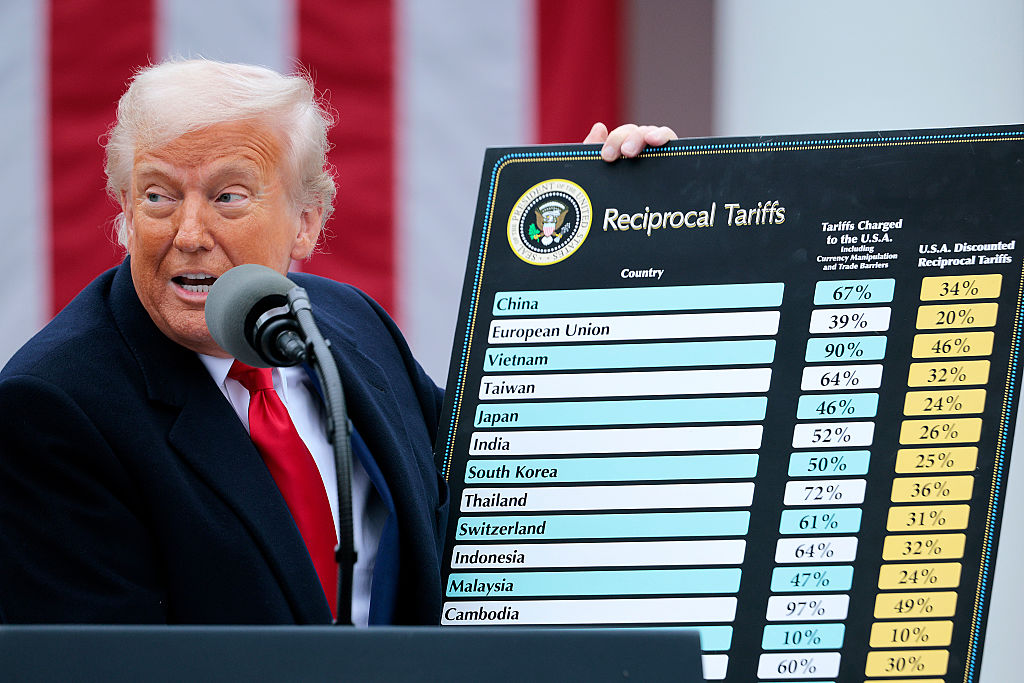Emotional investing: what is it and how you can avoid it
Are you an emotional investor? Your feelings could be damaging your long-term investments, but here's how to stay rational when the markets are turbulent.


Whether it’s fear, anxiety or excitement, the chances are we’ve all let our emotions take over when it comes to making investment decisions.
But understanding when you’re acting emotionally and limiting the impact it has on your portfolio is key to long-term success, especially during periods of market volatility.
As Morgan Housel, author of The Psychology of Money, says in his book: “people do some crazy things with money. But no-one is crazy.”
MoneyWeek
Subscribe to MoneyWeek today and get your first six magazine issues absolutely FREE

Sign up to Money Morning
Don't miss the latest investment and personal finances news, market analysis, plus money-saving tips with our free twice-daily newsletter
Don't miss the latest investment and personal finances news, market analysis, plus money-saving tips with our free twice-daily newsletter
The point Housel is making is that rationality with money looks different to every person. The attitudes and preconceptions that each of us holds towards money, as well as different individual asset classes like stocks, funds, commodities or bonds, is shaped indelibly by the financial (and, to a lesser extent, macroeconomic) conditions of our childhood.
It’s an interesting starting point for a book which, at its heart, is all about how to invest sensibly and steadily over the long term, without allowing emotion to take over.
Investors could have been forgiven for allowing a heavy dose of fear to creep into their decision-making over the last couple of months. Global stocks tanked in the wake of swingeing “reciprocal” tariffs that US president Donald Trump announced on 2 April, ‘Liberation Day’. The S&P 500 fell over 12% in just four trading days following the announcement.

Global financial markets went into turmoil in the aftermath of Donald Trump’s ‘Liberation Day’ tariff announcements, as fear took hold of global investors.
It takes a heart of stone to watch your timestakingly-accrued capital diminish at the stroke of a Washington pen, without immediately rushing for a safety net.
“Market volatility can be unsettling, yet it has become a more familiar part of the investment journey after several years of global uncertainty,” says Claire Exley, head of financial advice and guidance at JP Morgan-owned Nutmeg.
However, within a month of Liberation Day the S&P 500 had recovered to above its level just before its crash: it has now recovered from declines of 10% or more 25 times since 1928.
Those investors who succumbed to fear at the start of the turmoil and sold off their holdings ended up worse off. So, what steps can you take to strip emotion out of your investment decisions?
How to avoid emotional investing
While keeping emotion out of investing is easier said than done, there are several steps investors can take to minimise its impact on their decisionmaking.
“If people are considering investing, maintaining a long-term investment strategy can help lead to favourable returns, especially when markets are volatile,” says Jonathan Watts-Lay, director at workplace savings specialist Wealth at work.
Here are top tips for investing during turbulent times:
Make the most of tax-free allowances
In particular, capital gains tax (CGT) allowance and ISA contributions.
You can allocate up to £20,000 per annum across any number of ISAs, whether that’s putting savings into a cash ISA or investing into a stocks and shares ISA, or a combination. The income generated is tax-exempt and, if you do end up selling investments, they aren’t subject to CGT.
Being disciplined about maximising your ISA limit is a good way to ensure that investing and saving becomes a habit that you keep up routinely, rather than something you only do occasionally. Routine will help keep the emotion out of your investing; whether that’s by following a monthly drip-feed strategy or by investing a lump sum at the start of the tax year.
Either way, you’ll have a pattern you can follow, rain or shine, without letting the market’s ups and downs impact your decisions emotionally.
There is also the CGT threshold for any investments you sell at a profit from outside an ISA. While the CGT allowance has been reduced from £12,300 to £3,000 in recent years, this still gives you a small amount of tax-free profit you can take every year from assets that are outside your ISA. Plan your allocations and sales accordingly to maximise this benefit (with the input of a financial adviser if possible); this way, decisions to sell are deliberate and pre-planned, rather than emotional responses to market movements.
Focus on longevity
The short-term ups and downs of the stock market will always trigger our emotional response. But to invest sensibly over the long term, it's important to block this out.
The fear and panic that gripped global markets during the Liberation Day fallout allowed many to hold their nerve and exploit a buying opportunity, according to data from Charles Stanley.
Charles Stanley’s research found that 31% of UK DIY investors bought stocks and shares during the post-Liberation Day market dip.
“A large cohort of DIY investors were not simply looking to sell-up or ride out the wave, but saw the market turmoil as an opportunity to seek discounts and reposition their investments,” says Rob Morgan, chief investment analyst at Charles Stanley Direct.
The research also found that 13% of investors sold some of their assets that had been negatively impacted by the market moves, and a further 11% sold assets at a loss during the period.
The investors who were brave enough to buy the dip bought up plenty of assets on the cheap – effectively profiting from those who panic-sold. It goes to show the value in staying calm while others are succumbing to fear of loss.
“Most investors don’t lose money because they make bad picks – they lose because they act at the wrong time, for the wrong reasons,” says Greg Davies, head of behavioural finance at Oxford Risk.
Ensure investments suit your goals and attitude to risk
Consider how much risk you’re willing to take and the timeline over which you may want to access your investments again.
Our attitudes towards risk are a function of our emotional views of financial markets. Investing inherently involves a certain level of risk, but the amount (and type) of risk to take depends on your investment horizon and your personal circumstances.
Brits typically tend to be relatively optimistic about the stock market, according to data from eToro.
| Header Cell - Column 0 | UK | US | Germany | Australia | France | Spain | Italy | Netherlands |
|---|---|---|---|---|---|---|---|---|
Fear of loss | 37% | 43% | 41% | 37% | 42% | 46% | 61% | 35% |
Optimism | 36% | 35% | 34% | 35% | 24% | 31% | 20% | 29% |
Excitement | 20% | 22% | 16% | 23% | 11% | 14% | 12% | 17% |
Impatience | 13% | 17% | 25% | 17% | 14% | 21% | 18% | 21% |
Overconfidence | 15% | 15% | 9% | 15% | 13% | 23% | 17% | 16% |
Greed | 10% | 12% | 11% | 13% | 41% | 11% | 8% | 11% |
Panic | 12% | 14% | 12% | 13% | 9% | 10% | 9% | 10% |
Fear of Missing Out | 13% | 14% | 6% | 19% | 5% | 15% | 7% | 11% |
Source: eToro
While eToro’s study of 10,000 retail investors across 12 countries revealed that Brits are “optimistic, disciplined, and resilient”, in the words of Dan Moczulski, managing director at eToro, it also identified a psychological impact of seeing investments fall: half of UK investors said that declining investment value prompted them to become more cautious.
“Experiencing losses often triggers a natural psychological response, prompting investors to protect their remaining capital,” said Lale Akoner, global market strategist at eToro. “However, these setbacks also build resilience, leading to greater confidence and perseverance in navigating market fluctuations.”
Having a clear understanding of the levels of risk that you’re happy to take, and the timeframe in which you’re planning to exit any given investment, enables you to take a more emotionally detached stance on short-term losses.
Build a portfolio with global reach
Global diversification gives your portfolio resilience against specific areas of volatility.
"Ensuring your investments are globally diverse – so that risk is spread across multiple sectors, industries, and markets – is often the first step in building a resilient portfolio," says Pacome Breton, head of portfolio management at Nutmeg.
Global diversification is another way to bring discipline into your investing, rather than relying on your subjective views of particular markets that you think will outperform. This is especially important in avoiding falling into the herd mentality that can arise when certain markets become overvalued.
“When prices are high, expectations are high, and when expectations are high, so is risk,” said Rob Perrone, investment specialist at Orbis Investments. “It is way easier for the market to be disappointed when it is already exuberant.”
Get the latest financial news, insights and expert analysis from our award-winning MoneyWeek team, to help you understand what really matters when it comes to your finances.

Dan is a financial journalist who, prior to joining MoneyWeek, spent five years writing for OPTO, an investment magazine focused on growth and technology stocks, ETFs and thematic investing.
Before becoming a writer, Dan spent six years working in talent acquisition in the tech sector, including for credit scoring start-up ClearScore where he first developed an interest in personal finance.
Dan studied Social Anthropology and Management at Sidney Sussex College and the Judge Business School, Cambridge University. Outside finance, he also enjoys travel writing, and has edited two published travel books.
-
 Cash ISA cuts: millions of savers face £1,200 tax bill after five years
Cash ISA cuts: millions of savers face £1,200 tax bill after five yearsA combination of cuts to the cash ISA allowance and higher income tax on savings will deal a blow to savers as many could face a tax bill
-
 No peace dividend in Trump's Russia-Ukraine peace plan
No peace dividend in Trump's Russia-Ukraine peace planOpinion An end to fighting in Ukraine will hurt defence shares in the short term, but the boom is likely to continue given US isolationism, says Matthew Lynn